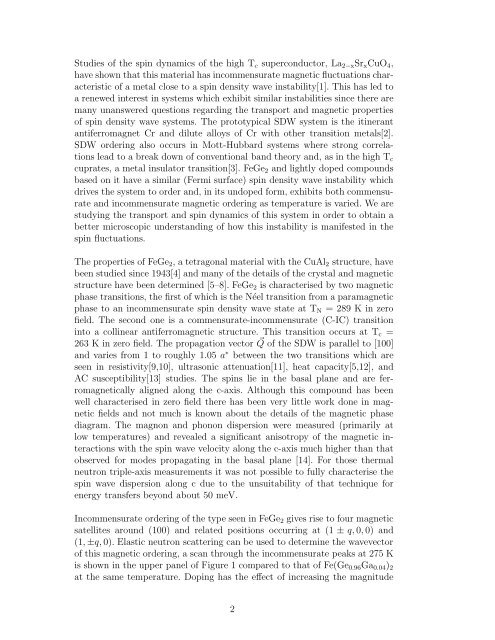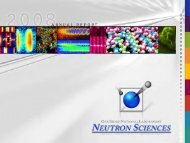ARCS materials - Spallation Neutron Source - Oak Ridge National ...
ARCS materials - Spallation Neutron Source - Oak Ridge National ...
ARCS materials - Spallation Neutron Source - Oak Ridge National ...
Create successful ePaper yourself
Turn your PDF publications into a flip-book with our unique Google optimized e-Paper software.
Studies of the spin dynamics of the high Tc superconductor, La2−xSrxCuO4,<br />
have shown that this material has incommensurate magnetic fluctuations characteristic<br />
of a metal close to a spin density wave instability[1]. This has led to<br />
a renewed interest in systems which exhibit similar instabilities since there are<br />
many unanswered questions regarding the transport and magnetic properties<br />
of spin density wave systems. The prototypical SDW system is the itinerant<br />
antiferromagnet Cr and dilute alloys of Cr with other transition metals[2].<br />
SDW ordering also occurs in Mott-Hubbard systems where strong correlations<br />
lead to a break down of conventional band theory and, as in the high Tc<br />
cuprates, a metal insulator transition[3]. FeGe2 and lightly doped compounds<br />
based on it have a similar (Fermi surface) spin density wave instability which<br />
drives the system to order and, in its undoped form, exhibits both commensurate<br />
and incommensurate magnetic ordering as temperature is varied. We are<br />
studying the transport and spin dynamics of this system in order to obtain a<br />
better microscopic understanding of how this instability is manifested in the<br />
spin fluctuations.<br />
The properties of FeGe2, a tetragonal material with the CuAl2 structure, have<br />
been studied since 1943[4] and many of the details of the crystal and magnetic<br />
structure have been determined [5–8]. FeGe2 is characterised by two magnetic<br />
phase transitions, the first of which is the Néel transition from a paramagnetic<br />
phase to an incommensurate spin density wave state at TN = 289 K in zero<br />
field. The second one is a commensurate-incommensurate (C-IC) transition<br />
into a collinear antiferromagnetic structure. This transition occurs at Tc =<br />
263 K in zero field. The propagation vector Q of the SDW is parallel to [100]<br />
and varies from 1 to roughly 1.05 a ∗ between the two transitions which are<br />
seen in resistivity[9,10], ultrasonic attenuation[11], heat capacity[5,12], and<br />
AC susceptibility[13] studies. The spins lie in the basal plane and are ferromagnetically<br />
aligned along the c-axis. Although this compound has been<br />
well characterised in zero field there has been very little work done in magnetic<br />
fields and not much is known about the details of the magnetic phase<br />
diagram. The magnon and phonon dispersion were measured (primarily at<br />
low temperatures) and revealed a significant anisotropy of the magnetic interactions<br />
with the spin wave velocity along the c-axis much higher than that<br />
observed for modes propagating in the basal plane [14]. For those thermal<br />
neutron triple-axis measurements it was not possible to fully characterise the<br />
spin wave dispersion along c due to the unsuitability of that technique for<br />
energy transfers beyond about 50 meV.<br />
Incommensurate ordering of the type seen in FeGe2 gives rise to four magnetic<br />
satellites around (100) and related positions occurring at (1±q, 0, 0) and<br />
(1,±q, 0). Elastic neutron scattering can be used to determine the wavevector<br />
of this magnetic ordering, a scan through the incommensurate peaks at 275 K<br />
is shown in the upper panel of Figure 1 compared to that of Fe(Ge0.96Ga0.04)2<br />
at the same temperature. Doping has the effect of increasing the magnitude<br />
2

















